- ortopedickecentrum.sk - Anatomy (knee joint)
- upol.cz - Arthrosis of the knee joint
- solen.cz - Current international recommendations for the diagnosis and treatment of gonarthrosis
- edukafarm.cz - Grade III bilateral gonarthrosis
- artroza.com - Knee pain - gonarthrosis
Knee Osteoarthritis: slowly but surely destroying the knee joints, how to treat it?

One of the most common knee diseases is without fail arthritis of the knee - gonarthrosis. It is one of the most common degenerative diseases of the weight-bearing joints in general. Arthrotic changes cause stiffness in the joint, impaired mobility, pain that increases with the progression of the disease, deformities and deviations in axial position. Ultimately, they lead to irreversible damage to the synovial joint with the need for endoprosthesis. Catching the first signals, seeking medical help, proper treatment and diet can delay the whole process and alleviate suffering. How does gonarthrosis manifest itself and what are the options for its treatment?
Article content
Gonarthritis is a non-inflammatory, degenerative disease affecting up to 15% of the population. As with arthritis of other joints, it tends to increase with age.
The knees (and hips) are weight-bearing joints, which is why they are overloaded and preferentially develop osteoarthritis in these areas.
Structure and function of the joint
The joint (articulatio) is the place where two or more bones are joined together. One end of the bone is terminated by the articular head and the other by the articular socket, so that they fit together well. They form the basic surfaces of the joint and their surface is covered with hyaline cartilage. The irregularities between the head and the socket are filled by articular plates of cartilage (e.g. discs, menisci).
The joint is protected by an outer shell, called the joint capsule. The joint capsule consists of two basic parts. The outer part is made up of a solid layer of ligaments, surrounded in places by collagen fibres (ligaments). The inner, cavernous part of the joint is made up of a thin membrane, the synovial lining, which is moistened by a fluid made from blood plasma, called synovia.
Interesting fact: The hyaline cartilage covering the ends of the bones in the joint is composed of elastic ligaments. It is nourished by synovial (joint) fluid and diffusely from the bones. Its damage is irreversible and it does not have the ability to rebuild itself.
Specifics of the knee joint
The knee joint (articulatio genus) is the largest and most complex joint in the human body. Its stability and strength determine the overall posture, weight-bearing capacity and gait of a person. Hence its name or classification as a weight-bearing joint.
The head of the joint is formed by the end of the femur fitting into the joint cavity consisting of the upper part of the tibia. Two cartilages, the menisci, fill the centre of the femur and the tibia. The menisci are shaped like two crescents and connect to the tibia. Unlike other joints, two separate ligaments cross inside the knee joint.
At the front of the knee joint is the patella, which is covered on the sides by the lateral ligaments. It is protected, covered and strengthened on the front by the tendon.
Interesting fact: The fibula (fibula, the second bone of the tibia) is not connected to the tibia at the knee joint or to the femur. The weight of the body and the overall weight-bearing capacity is mainly placed on the tibia. The fibula is too thin and weak to support the weight of a person. It breaks very often.
Functions of the knee joint
The knee joint provides movement in the knee area. Specifically, it provides flexion (bending), extension (stretching) and slight rotation (turning) when the knees are bent. These types of movement are necessary for walking and other types of movement (bending, squatting, standing, turning).

What is gonarthrosis and what happens in the joint viscera?
Gonarthrosis is a non-inflammatory, degenerative disease of the articular cartilage of the knee. It arises from various and in some cases not entirely clear causes. A certain etiology is aging. It affects preferentially the medial part at the level of the femoral-femoral and patellofemoral part.
Initial changes at the metabolic level cause destruction of bone mass. Under the influence of these catabolic processes, the damaged bone cartilage thins over time. Erosions and cracks develop, the articular surfaces become uneven and the articular cleft narrows. This results in deformation of the knee joint, deviation from the axial position and the resulting mobility disorders.
TIP: Stop arthritis
A knee joint damaged by an arthritic process causes knee stiffness, pain, outwardly visible deformities, and mobility problems. It puts the greatest strain on the patient when walking up stairs or bending over (e.g., putting on shoes). Standing up from a sitting position can also become a problem.
Catch the first signs of the disease!
The first warning signs of osteoarthritis as such include morning stiffness of the joints, which is the same in gonarthrosis. After moving around, the stiffness disappears. Subsequently, knee pain occurs with physical exertion or excessive loading of the knee joints (walking on uneven ground, squatting, walking up stairs). Rest pain does not occur at the beginning of the disease.
As the disease progresses (develops), pain at rest begins to appear. Typically, it worsens at the end of the day. Increasing deformities cause deviations in axial position. The first mobility disturbances (flexion, extension, rotation) appear. A well-known and typical symptom is flexion contracture. This is a gradually increasing flexion of the limb (bending) with an inability to extend (stretching).
Interesting: In gonarthrosis, there is a so-called giving way phenomenon, in which the affected limb falls uncontrollably. Patients are prone to falls and to injuries due to trauma. This is due to the increasing instability of the knee joint.
Table with initial and advanced symptoms of gonarthrosis
| Initial symptoms of gonarthrosis | Symptoms of advanced gonarthrosis |
|
|

Stages of gonarthrosis according to Kellgren-Lawrence
Gonarthrosis starts subtly and slowly. In the early stages, non-specific complaints often attributed to fatigue, exhaustion, excessive physical exertion or simply the natural aging process appear.
Initially, stiffness of the knee joints and mild pain usually occur after exertion. Patients usually seek medical attention only when they experience intense pain and mobility problems that limit their normal daily activities and occur at rest.
Stages of gonarthrosis according to Kellgren-Lawrence based on the progression of the disease in the cartilage
| Stages of gonarthrosis | Pathological process in the cartilage |
| Stage I |
|
| Stage II |
|
| Stage III |
|
| Stage IV |
|
Current treatment options for arthrosis of the knee
We can protect ourselves to a certain extent against the onset of gonarthrosis by living a healthy lifestyle, eating a healthy diet and not neglecting physical activity. However, ageing brings with it changes throughout the body. There are also changes to the bones and joints that are unavoidable. Later on, the only way to alleviate the symptoms of the disease is through proper treatment.

Non-pharmacological treatments for gonarthrosis
In the early stages of gonarthrosis, the symptoms are not so limiting and urgent. It is therefore advisable to follow some principles, thereby moderating the progression of the irreversible condition. These are basic measures that are not burdensome and are beneficial.
- Change of lifestyle (vitamins, collagen...)
- reduction of obesity
- regular physical activity without excessive strain on the knees
- proper footwear, orthopaedic aids
- instructional exercises with a physiotherapist
- massages
- electrotherapy
- cryotherapy
- acupuncture
- light therapy
Drug therapy
The treatment of gonarthrosis is essentially no different from other treatments for other joints affected by osteoarthritis. The drug of first choice is paracetamol. Suitable drugs and frequently used are non-steroidal antirheumatic drugs (e.g. ibalgin). They are also in the form of topical ointments with analgesic and anti-inflammatory effects.
In more severe cases, corticosteroids and hyaluronic acid are injected into the articular cartilage. In gonarthrosis, intra-articular administration of corticosteroids is preferred. Administration of chondrotin sulphate and glucosamine is appropriate.
In severe painful conditions, opioid analgesics (tramal, morphine) are also used to treat moderate to severe pain. However, their use is subject to prescription and is recommended only by a doctor.
Painkillers ranked by strength of analgesic effect
- paracetamol
- non-steroidal anti-inflammatory drugs
- corticosteroids and hyaluronic acid
- chondroitin sulphate, glucosamine
- opioid analgesics
Surgical and operative interventions when other treatments have failed
Incredibly, in today's advanced age, the first mention of joint replacement dates back to 1960. McKeever, a physician, attempted to replace a damaged joint with plates made of chromium-cobalt alloy.
5 surgical procedures for gonarthrosis
- partial knee replacement
- total knee replacement
- Osteotomy and preventive procedures
- joint lavage
- arthrodesis
Partial knee replacement - hemiarthroplasty
Total knee arthroplasty
Osteotomy and preventive surgery
These procedures are preferred in younger patients. They involve surgically opening the joint and cutting off, shortening the bone or making changes to its structure. The procedure is used to correct defects and eliminate pain. In older patients, surgical osteotomy and simultaneous joint replacement are combined.
Joint lavage and debridement
Joint lavage (joint flushing) and debridement (marrow-stimulating technique) are performed in patients with painful conditions. However, they provide only temporary relief and do not offer any prospect of long-term treatment or reversal of the pathological process. Although the momentary effect is beneficial for the patient in terms of pain control and improved mobility, it does not guarantee long-term improvement.
Arthrodesis
Arthrodesis is a surgical procedure indicated for gonarthrosis in which the joint replacement has failed. It is essentially a salvage procedure. Septic conditions in the knee are also indicated. It is performed using chisels and cutters to work the joint. The aim of the operation is to create a bony fusion of the affected joint. The result is a paradoxical restriction of movement in the joint that prevents pain and progression of the disease.
Interesting resources










